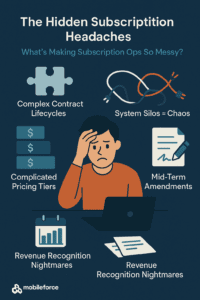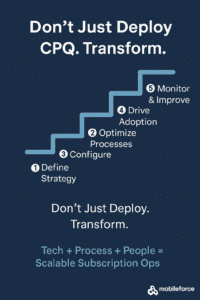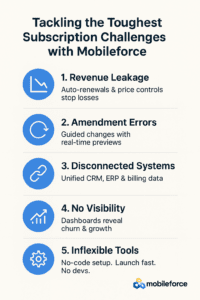

Mobileforce
- General Resources
Table of Contents
ToggleIntroduction: Welcome to the Subscription Economy
Just as software once transformed every industry it touched, subscriptions are reshaping how companies deliver value, build customer relationships, and generate revenue. From Netflix reshaping entertainment to Microsoft 365 redefining productivity to ChatGPT innovating in AI —and even extending to hardware and industrial equipment offered as a service—subscriptions are taking over. Businesses are quickly shifting from one-time sales to ongoing, relationship-driven recurring revenue models.

But behind this transformative shift lies an operational puzzle that many organizations are struggling to solve. Managing subscriptions at scale—complete with complex renewals, mid-term adjustments, intricate pricing strategies, and interconnected systems—is quickly overwhelming teams accustomed to simpler transactional models. Without robust processes and powerful automation, the promise of predictable revenue can devolve into chaos, revenue leakage, and frustrated customers.
Enter modern Configure, Price, Quote (CPQ) platforms. Initially designed as straightforward quoting tools, today’s CPQ solutions have evolved dramatically to become comprehensive subscription management systems. They handle the entire subscription lifecycle—from initial configuration and pricing, through renewals and amendments, right down to forecasting future revenue streams. Platforms like MobileForce are leading the charge, helping companies turn subscription complexity into a strategic advantage.
In this guide, we’ll dive deep into how CPQ technology has evolved to master subscription management, covering best practices for renewals, seamless handling of amendments, and proven strategies to accelerate recurring revenue growth. Whether you’re a subscription veteran or just beginning the journey, you’ll discover actionable insights to streamline operations, protect revenue, and build lasting customer relationships in the subscription economy.

The Hidden Challenges of Subscription Management
While the strategic benefits of subscription models are compelling, the operational demands are substantial and often underestimated. Consider what it takes to manage subscriptions effectively:
Contract Lifecycle Complexity
Imagine tracking thousands of contracts, each with diverse start dates, varying term lengths, and different renewal windows. Without automation, this complexity quickly spirals into a spreadsheet nightmare, inevitably resulting in missed renewals, revenue leakage, and customer dissatisfaction.
Pricing Structure Intricacies
Subscription pricing involves nuances that traditional sales models rarely face. Businesses must manage:
- Tiered pricing structures based on usage or number of users.
- Volume discounts that adjust dynamically based on commitment levels.
- Term-length incentives rewarding customers who commit to longer durations.
- Usage-based pricing components that fluctuate monthly.
- Scheduled renewal price increases, often accompanied by negotiated exceptions.
These variables create ongoing complexity that demands sophisticated pricing management tools.
Mid-Term Amendments
Unlike traditional, transactional models, subscription agreements often evolve mid-cycle. Such changes can include:
- Customers adding or removing users.
- Upgrading or downgrading service tiers.
- Modifying contract terms to meet changing business requirements.
- Adjusting plans to reflect new usage patterns.
Every adjustment triggers complex administrative workflows involving prorations, credit calculations, updated billing schedules, and formal contract amendments. Without automated workflows, this becomes error-prone and highly resource-intensive.
Revenue Recognition Challenges
Revenue recognition in subscription models is tightly regulated by accounting standards, such as ASC 606. Compliance requires meticulous tracking of:
- Detailed contract terms and conditions.
- Performance obligations clearly outlined in each agreement.
- Precise and timely billing schedules.
This level of detail demands advanced systems capable of maintaining comprehensive visibility and accuracy.
System Fragmentation
Perhaps the greatest operational hurdle is coordinating data across fragmented systems. Subscription management typically involves multiple specialized systems, including:
- CRM platforms tracking customer interactions.
- CPQ systems generating accurate quotes and contracts.
- Billing platforms responsible for payment collection.
- ERP systems managing overall financial records.
- Provisioning systems that activate and manage service delivery.
Without seamless integration, these systems become like disjointed data pockets that hold back integrated value for the organization.

The Evolution of CPQ: From Quote Generator to Subscription Engine
Configure, Price, Quote (CPQ) systems have undergone a remarkable transformation in recent years. Originally designed to streamline complex product configurations and pricing calculations for one-time sales, modern CPQ platforms have evolved into sophisticated subscription management engines.
The Traditional CPQ Approach
In the pre-subscription era, CPQ systems focused on:
- Product configuration rules
- Price list management
- Basic quote generation and approval workflows
- Proposal document creation
While valuable for complex product sales, these capabilities were insufficient for managing ongoing subscription relationships.
The Modern Subscription CPQ
Today’s advanced CPQ platforms like Mobileforce deliver significantly expanded functionality:
- Full contract lifecycle management
- Automated renewal generation and processing
- Mid-term amendment workflows
- Recurring revenue forecasting and analytics
- Multi-period billing schedule creation
- Self-service customer portals
- Revenue recognition rule application
This evolution has transformed CPQ from a sales productivity tool to a strategic revenue management platform—the central nervous system for subscription-based businesses that orchestrates complex processes across departments and systems.

Key Capabilities for Subscription Management Success
Modern CPQ platforms have evolved to support the full lifecycle of subscription businesses. Here are three critical capabilities that drive recurring revenue success:
1. Mastering Renewal Automation
Renewals are the heartbeat of subscription businesses, preserving existing revenue and opening doors to expansion. Yet they come with complexities:
Challenges:
- Diverse contract terms (monthly, annual, multi-year) with varying notice periods
- Co-termination requirements to align multiple products
- Price increases, upgrades, and evolving product configurations
How CPQ Solves It:
- Automated Triggers: Initiates renewals based on time, usage, or lifecycle milestones
- Smart Quote Generation: Includes current subscriptions, uplifts, discounts, and new product recommendations
- Flexible Execution: Supports sales-assisted, self-service, automated, or hybrid models
- Renewal Insights: Dashboards, renewal rate tracking, and early churn indicators for proactive action
Impact: Businesses typically see a 10–20% increase in renewal rates and 5–8% lift in renewal revenue.
2. Streamlining Contract Amendments and Mid-Cycle Changes
Subscriptions don’t stand still. Mid-term changes—whether adding users, upgrading plans, or adjusting contract terms—create administrative burden.
Challenges:
- Prorated billing, co-termination, credits, and revenue recognition
How CPQ Solves It:
- Guided Workflows for add-ons, upgrades, quantity or term changes
- Automated Math: Handles prorations, co-termination, uplift adjustments, and credits
- Impact Visibility: Shows revenue deltas, billing adjustments, and TCV before changes go live
Result: Up to 80% reduction in amendment processing time, fewer errors, and improved customer satisfaction.
3. Managing the End-to-End Subscription Lifecycle
Subscription businesses demand more than a simple quote tool. End-to-end lifecycle management is essential to scale effectively.
Challenges:
- Complex product configurations, pricing rules, and multi-period billing coordination
- Contract fulfillment, provisioning, and renewal tracking across multiple systems
How CPQ Solves It:
- Flexible Configuration: Supports subscription terms, usage models, entitlements, and service bundling
- Advanced Pricing Models: Handles tiered, volume, term-based discounts, hybrid pricing, and promotional offers
- Comprehensive Quote Creation: Includes multi-period billing, SLAs, usage policies, and renewal terms
- Seamless Contracting & Fulfillment: Automates contract creation, e-signature capture, provisioning, and renewal workflows
Value: Eliminates deal friction, accelerates time-to-revenue, and enables subscription scale.

Implementing Subscription Management: A Strategic Framework
Successfully implementing subscription management capabilities isn’t just a technical exercise—it requires orchestrating people, process, and technology in harmony. Here’s a proven five-step approach to ensure long-term impact:
1. Define a Clear Subscription Strategy
Start with the fundamentals before touching any technology. A well-articulated strategy will shape every downstream decision.
What to Define:
- Offering Structure: Product tiers, packaging, and optional add-ons
- Pricing Architecture: Base rates, volume discounts, term incentives
- Billing Cadence: Timing for payments—monthly, quarterly, annually
- Renewal Policy: Uplift percentages, notice periods, co-termination logic
- Amendment Rules: Proration methods and mid-term change policies
Why it matters: These choices create the blueprint for effective system configuration.
2. Map and Optimize Key Processes
Don’t automate chaos. Before implementation, take the time to understand and improve existing workflows.
Steps to Follow:
- Current State Assessment: Document how things work today
- Pain Point Identification: Pinpoint bottlenecks and inefficiencies
- Future State Design: Build an ideal process flow for subscription journeys
- Role Definition: Clarify who owns what
- Approval Hierarchy: Define authorization levels to reduce delays and risk
Outcome: Clean, efficient processes that technology can enhance—not just replicate.
3. Configure Systems for Agility and Scale
System configuration should reflect current needs—but also leave room to grow.
Implementation Priorities:
- Product Catalog Setup: Build out subscription offerings with accurate attributes
- Pricing Rule Configuration: Encode your chosen pricing models and incentives
- Document Templates: Generate professional contracts and quotes quickly
- Workflow Automation: Establish routing, alerts, and approval logic
- System Integration: Connect CRM, ERP, and billing systems to maintain a single source of truth
Result: A flexible system that supports business evolution, not just today’s needs.
4. Drive Adoption Through Change Management
Even the best systems fail without people behind them. Invest in education and enablement.
Change Enablement Tactics:
- Stakeholder Education: Explain the “why” behind the transformation
- Role-Based Training: Tailor sessions to the needs of sales, finance, and customer success
- Process Documentation: Make instructions easy to access and use
- Hands-On Simulation: Practice real-world subscription scenarios
- Ongoing Support: Provide help desks or internal champions post-launch
Key takeaway: Success depends on people embracing—not resisting—new processes.
5. Monitor, Learn, and Optimize Continuously
Subscription management isn’t “set it and forget it.” Treat it as a living system.
Optimization Playbook:
- Performance Monitoring: Track KPIs like renewal rates, churn, and amendment cycles
- User Feedback: Gather input regularly to spot friction points
- Rule Updates: Tweak configurations as your offerings evolve
- Capability Expansion: Unlock advanced features when business needs arise
- Best Practices: Adopt innovations from leaders in your space
Mindset shift: Continuous improvement is the real secret to long-term ROI.

Why Mobileforce Is the Ideal CPQ for Subscription Management
Mobileforce has rapidly emerged as the definitive solution for organizations navigating the complexities of subscription-based revenue. Designed from the ground up to address the realities of modern recurring revenue models, Mobileforce delivers unmatched agility, intelligence, and execution through its purpose-built architecture and no-code configuration capabilities.
Unparalleled Lifecycle Intelligence
Mobileforce provides a full-spectrum view into your subscription business. From initial sales to renewals and expansions, the platform ensures every stage is data-driven and aligned with business goals.
Key Differentiators:
- Revenue Classification Engine: Automatically categorizes subscription activity—new business, expansions, contractions, churn
- Cohort Analysis: Tracks performance across customer segments and vintages for deeper insights
- Health Scoring: Flags at-risk accounts using engagement and adoption metrics
- Revenue Bridge Analysis: Visualizes period-over-period ARR/MRR movements to support executive decision-making
Smarter Bundling and Recommendations
The platform doesn’t just configure—it recommends. Mobileforce enhances sales effectiveness with intelligent bundling logic and real-time suggestions.
Capabilities Include:
- Contextual Recommendations: Tailored product suggestions based on customer profile
- Bundle Optimization: Dynamically assembles high-conversion, high-value packages
- Compatibility Management: Prevents technically or commercially invalid configurations
- Whitespace Analysis: Identifies overlooked upsell or cross-sell opportunities
Advanced Renewal Management at Scale
Renewals don’t have to be reactive. Mobileforce automates and enforces best practices through:
- Multi-Tier Uplift Rules: Applies segment-specific renewal pricing
- Exception Management: Tracks and escalates deviations from standard terms
- Incentive Programs: Supports early renewal discounts and promotional offers
- Bulk Renewal Processing: Handles large volumes with minimal manual effort
Organizations using Mobileforce increase renewal rates by 10–20% and recover 5–8% in previously missed revenue.
Actionable Revenue Intelligence
Mobileforce transforms subscription data into strategic foresight:
- ARR/MRR Waterfall Charts: Breakdown of revenue by source over time
- Forecast Models: Project growth and identify headwinds before they manifest
- Churn Prediction: Early warnings for customer attrition
- Customer Lifetime Value Analytics: Evaluate long-term account profitability
Users typically reduce forecasting variance by 40–50%, enabling sharper, faster decision-making.
Built for Change: No-Code Flexibility
In a market where speed wins, Mobileforce delivers agility without sacrificing governance. Business users can adapt the system without depending on IT or external developers.
Standout Features:
- Visual Rule Builder: Create pricing logic, eligibility rules, and workflows on the fly
- Template Designer: Generate branded, compliant quotes and contracts in minutes
- Workflow Editor: Design approval and routing paths with a drag-and-drop interface
- Integration Hub: Seamlessly connect with CRM, ERP, billing, and provisioning platforms
Most customers launch new pricing models or offerings 60–80% faster than with legacy CPQ solutions.

Tackling the Toughest Subscription Challenges with Mobileforce
Subscription businesses encounter a familiar set of obstacles as they scale. What sets Mobileforce apart is how comprehensively and elegantly it addresses these pain points—not with bolt-on patches, but with a unified, purpose-built platform. Here’s how it tackles the five most common challenges:
Challenge 1: Revenue Leakage from Missed or Underpriced Renewals
Mobileforce eliminates missed opportunities with automated renewal triggers, uplift governance, and centralized dashboards that ensure every renewal is tracked and executed at the right price.
Challenge 2: Inefficiencies and Errors in Contract Amendments
Mobileforce streamlines mid-cycle changes through guided workflows, real-time financial previews, and automated adjustments that reduce processing time and errors.
Challenge 3: Disconnected Systems and Data Inconsistency
Mobileforce unifies your tech stack with bi-directional CRM, ERP, and billing integrations, creating a single source of truth for all subscription terms and activities.
Challenge 4: Lack of Visibility into Subscription Performance
Mobileforce delivers purpose-built dashboards and predictive analytics to illuminate churn risks, revenue drivers, and future growth paths.
Challenge 5: Inflexible Systems That Slow Innovation
Mobileforce empowers business users with no-code tools to launch new models, products, or workflows—without developer dependence or delays.
To sum it up, Mobileforce transforms subscription management from an operational burden into a strategic advantage—turning recurring complexity into recurring value.
Conclusion: Transforming Subscription Complexity into Competitive Advantage
In today’s subscription economy, operational excellence is as important as product innovation. Organizations that streamline subscription management create fundamental advantages:
- Revenue Optimization: Maximizing customer lifetime value through effective renewals and expansions
- Operational Efficiency: Reducing administrative costs while improving scalability
- Customer Experience: Creating frictionless interactions throughout the subscription lifecycle
- Business Agility: Adapting quickly to market changes and competitive pressures
- Strategic Insight: Understanding subscription performance drivers and trends
Modern CPQ platforms like Mobileforce transform what could be operational chaos into strategic advantage. By automating complex processes, enforcing consistent policies, and providing actionable intelligence, they enable businesses to focus on customer relationships and innovation rather than administrative firefighting.
As subscription models continue to evolve across industries, the distinction between leaders and laggards will increasingly depend on operational execution. Organizations that implement sophisticated subscription management capabilities now are positioning themselves for sustainable competitive advantage in the recurring revenue economy.
FAQs
What types of businesses benefit most from automated subscription management in CPQ?
Any organization with recurring revenue stands to benefit—but the impact is especially powerful for businesses with numerous and/or high-volume contracts, complex pricing, and multi-channel operations. If you’re dealing with thousands of contracts, usage-based billing, compliance requirements, or rapid growth, manual processes will eventually break. That’s where CPQ platforms like Mobileforce shine—bringing structure, automation, and scalability to environments that are otherwise hard to manage.
How is subscription management in CPQ different from subscription billing platforms?
Think of it this way: CPQ defines the terms of the relationship; billing enforces them.
Subscription management in CPQ handles upfront configuration—like setting prices, generating contracts, processing amendments, and automating renewals. Billing platforms, on the other hand, take over once the deal is closed, managing payment schedules, processing invoices, applying taxes, and ensuring revenue recognition compliance.
Most high-performing organizations use both systems together—CPQ to manage complexity at the front-end, and billing to ensure financial execution at the back-end.
How long does it take to implement subscription management in CPQ?
It depends on how sophisticated your needs are. A basic setup can be up and running in 4–8 weeks. If you’re integrating across CRM, ERP, and billing platforms, plan for 8–12 weeks. More complex deployments involving custom workflows or pricing logic may stretch to 12–16 weeks.
The good news? Mobileforce’s no-code architecture speeds things up significantly compared to traditional CPQ platforms, meaning you can realize value faster.
How does Mobileforce support usage-based or consumption pricing?
Mobileforce is purpose-built for hybrid subscription models. It can integrate with usage tracking systems, apply tiered or overage rates automatically, manage prepaid drawdowns, and even forecast future usage based on historical trends. So whether you’re billing per seat, per transaction, or per gigabyte, Mobileforce adapts—without custom code.
What metrics should we track to measure success?
Look at both operational and financial performance.
On the operations side, focus on quote turnaround time, amendment processing speed, and system adoption across teams. Financially, track renewal rates, uplift at renewal, expansion revenue, and customer lifetime value. These indicators show whether your subscription engine is firing on all cylinders—and Mobileforce provides dashboards to keep you on top of them all.
Questions?
Have questions? Our team is happy to walk through your subscription management challenges and discuss options tailored to your unique business – click here to contact us.




